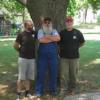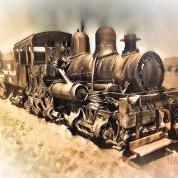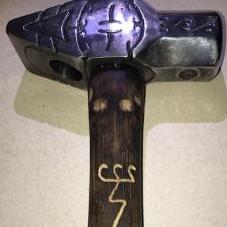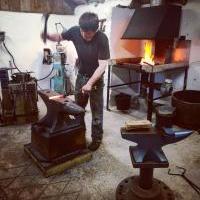-
Posts
1,484 -
Joined
-
Last visited
Profile Information
-
Gender
Male
-
Location
Bloomfield Iowa U.S.A.
-
Interests
You can't clear the water up till you've got the pigs out of the creek.
Converted
-
Location
Bloomfield, Iowa U.S.A.
-
Occupation
Blacksmith, Welder
Recent Profile Visitors
11,974 profile views
-
I recently freed one with heat (#3 tip on the Dillon ). Soaked it with Kroil for couple days, then heated the nut. Repeated 3-4 times I think. This was done with the repair vise clamped in my shop leg vise. Was a stubborn one. Eventually powdered corrosion came out when the screw moved. Is now a very usable vise. Will take the recipes posted here under advisement, thanks. I have used Marvel Mystery Oil with success.
-
Nice lookin vise ! Thomas and the folks have given you plenty of information. This vise could be adapted to more than one use.
-

Auto-darkening shields and welders flash
Ten Hammers replied to Crazy Ivan's topic in Welding/Fab General Discussion
I've welded thousands of pieces and parts win an automatic lens ( Huntsman ). Not a cheap one. What Coleen said for sure. I still have the green shade 10 Jackson and I actually have ( somewhere) an old Huntsman I got 40 years ago. The Jackson is the prize. The auto is in a Huntsman. I've been burned eyes anyway) twice. Both times at home with my own plasma. You see those idiots on TV running a plasma bare eyed. I got it around the edges of my old shade 5's. Ivan, i hope you find the problem. My guess is outside, you need the fixed lens. Welding with a 400 amp pulse welder and a partner you will get burned (skin ) if you raise the helmet too quickly for sure. You folks are experienced and knew this. -
Peter Ross is an incredible teacher. I sat within 10 feet of him for almost 2 days at the BAM conference last weekend. One hammer ( likely 1 1/4 lb ) and a few BAM tools ( tongs, top tools ). He did incredible work including steel and wrought. ZERO use of a brush and the pile of scale on the floor was almost nothing. VERY clean work.
-
You must take into consideration the fact that well placed blows on a well placed piece of stock at the right starting heat will make LARGE difference. Drawing points on 3/8 square compared to 1/2 square ( square points same length ) off the far side and using 6 blows on each size of stock can be accomplished fairly easily. This with a 2 1/2 - 3 lb hammer (my choice anyway). The trick is to have the right combination of top/bottom tool to forge the points in the most efficient way ( and maybe a few dress blows afterward too ). You will yes use larger strokes and harder blows on the larger stock but the same can be accomplished. The physics involved has been discussed. None of this makes a large difference if you don't have absolute control of the blows made ( and I mean hand swung blows ). If I were to have another hammer of the same handle stock and type with a larger head I MIGHT be able to move more but don't know. I can point 48 of what I listed ( running a gasser ) in not that long of time. I might add that the smith running the hammer and the specific needs will dictate the size of the hammer as well. I tend to go a bit on the heavier side but I'm not a farrier.
-
Tightening does indeed work well on occasion. If the hole is a through hole ( and the bolt is broken in the hole) use a standard drill. The bolt can then have the option of going through. If a blind hole or other area where you must have the fastener come back out, use a left hand drill. Right hand drill will tighten the fastener in the hole. I have used square tapered extractors but not in years. Your Mileage may vary. I have used flat stock, angle iron and or nuts and welded this to the inside of the hole or to the screw head. A slight turn tightening and let it set sometimes is the ticket, sometimes not. I use ATF or Kroil these days more than anything but Marvel Mystery oil works very well. Some larger ones in castings just have to be blown out with a torch and than use a cape chisel to clean the hole and run a tap trough to clean up.. Indeed a soak and a 6 point socket may solve the issue and save the bolt too.
-
Thanks Frank. Always nice to learn..
-
To the family, please accept my prayers. Ed was a heck of a guy. We talked into the night about many things. Many years ago.
-
Some will disagree. The quality of the steel will make a difference. The first heat (bloody hot for my choices ) will make large difference. Drawing square ( rotating 45º back and forth ) taper rather fast and gaining heat on the tip (this on the far side and distal end off the edge) will be the best way for me. Perhaps leave the end not really sharp before going back to the start of the taper to start rounding. JNewman has my thoughts by hex first but honestly sometimes this process happens pretty fast and my head says " just keep it under control ". This means don't let it split and keep it smooth. Most days this works well. Some days you the coyote, some days the post. Drawing on the power hammer may be a bit different. Drawing round will make a spiral and this can be rotated either way to correct it. Regardless, the start of the drawing to taper for me should be with a pinch past the far side and striking ON the far side. This creates a bit of a knob with a taper behind it. This knob can then be drawn in a couple of blows to create the initial point. Pointing 5/8 or 3/4 rod for tripod ends is accomplished in one heat this way. No need in that issue to round afterwords because all you are doing is sharpening the end. We all have different wants and needs. I find these things I have described tough to do in gas forge for the large part. Gas excels in other areas.
-

Peter Wright found in Alaksa
Ten Hammers replied to K. Bryan Morgan's topic in Anvils, Swage Blocks, and Mandrels
Good score KBryan. Lot of work can be done on that. -
LP was over 5 bucks locally last week.
-

Anybody know what these are?????
Ten Hammers replied to billymons's topic in Blacksmithing, General Discussion
Guards for a sickle bar mower. They will be mallable and bend a bit. We can still buy sickle sections locally but most under 40 don't know what they are ( Krone and the rest of the rotary mowers replaced sickles). Guards can be used for bottom tools to punch rivets of various kinds out of other things etc. I have grown up with them and they come in singles, doubles and ends. they come in various manufacturers and sometimes sizes ( depending on the mower ). Attached is a link to a picture of a Ford mounted mower: http://www.ebay.com/itm/Ford-Series-515-Sickle-Bar-Mower-/231127010792




.thumb.jpg.04efa31b17e0217d84870be46a7a0461.jpg)